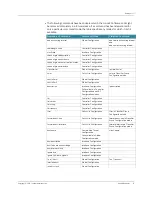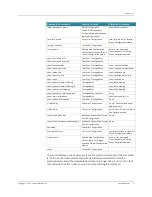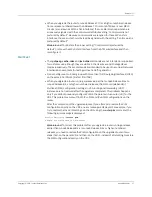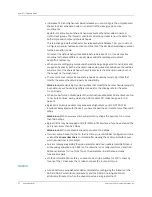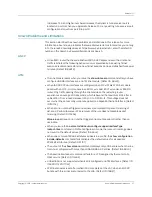
Copyright © 2010, Juniper Networks, Inc.
Known Behavior
23
Release 11.1.1
Work-around
: Before you upgrade from an affected release to JunosE Release
9.2.0p1-0 or higher-numbered releases, ensure that you do the following:
−
Change IP interface and subinterface descriptions to 9 or more characters.
−
Change VRF descriptions, VRF names, or both so that the combination of
associated VRF names and descriptions consists of 9 or more characters.
z
The
ip tcp adjust-mss
command, which modifies the maximum segment size for
TCP SYN packets traveling through the interface, is not supported on the ES2 10G LM
or ES2 10G Uplink LM.
z
If you have enabled ipInterface logging at a priority of debug, the acknowledgment
that an interface has been deleted from the line modules can return to the SRP
module after the layers beneath IP have deleted their interfaces. Consequently, the
original name of the interface cannot be resolved or displayed in the log, and the
system instead displays the ifIndex of the IP interface. This behavior has no
functional effect other than that the log is misleading. However, previous log events
indicate that the interface deletion was beginning.
z
When you want to use a configuration script to configure IP shared interfaces that
reference a physical interface, you must issue the
service show configuration format
2
command before you generate the script. If the default
show configuration
format
(format 1) is enabled instead, the generated script cannot properly configure the IP
shared interfaces because they are created before the physical interfaces. To
properly configure the shared interfaces in this event, run the generated format 1
script twice.
z
When you issue the
show ip forwarding-table
command for a particular slot, it is
normal and appropriate behavior when the Status field indicates Valid while the
Load Errors field is increasing daily for that VR. The Load Errors field records any
failed routing table distribution attempt as an error. Attempts can fail for many
reasons during normal operation; a failed attempt does not necessarily indicate a
problem. It is normal to see many load errors per day. If the Status field indicates
Invalid, then the routing table distribution has failed constantly for that VR and a real
problem exists. You might occasionally see a status of Updating. However, if the
Status field always indicates Updating, then again the routing table distribution has
failed constantly for that VR, and a real problem exists.
z
The enhancement to the CLI to support unnumbered reference to any kind of
interface rather than just loopback interfaces has consequences such as the
following: [Defect ID 47743]
−
If the references to shared interfaces appear in the
show configuration
output
before the configuration for the interfaces they refer to, trying to restore such a
configuration with a script generated from
show configuration
generates errors
like the following:
% Error, line 3929:
host1(config-if)#ip share-interface FastEthernet 3/0.2
% No such interface
−
Unnumbered interfaces that refer to nonloopback interfaces (for example,
ip unnumbered fastEthernet 3/0.2
) and that appear in the
show configuration
output before the interface referred to might generate similar no such interface
errors.
Work-around
: Run the script twice.







